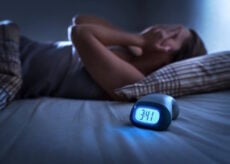Why You Get Acne on Certain Parts of Your Face
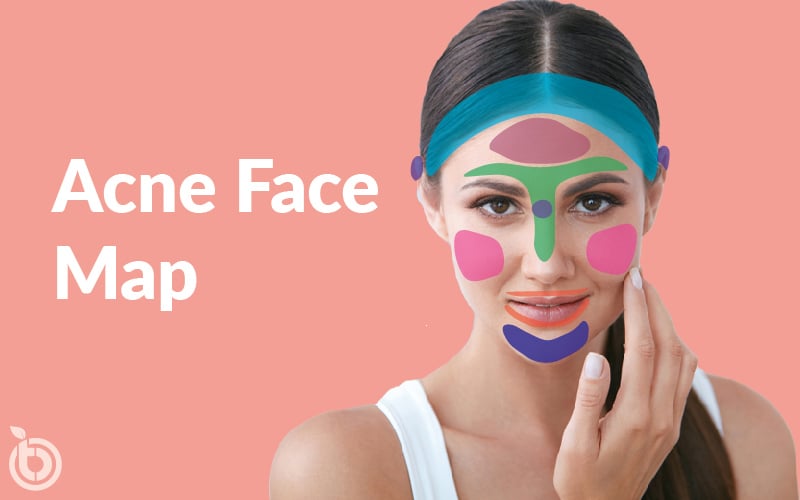
If you’re human, you’ve likely had a pimple, blackhead, whitehead, or other types of blemishes pop up on your face from time to time. Often, seemingly at the worst time, say, before a date or an interview. If you think that you’ll outgrow pimples at some point, I might have some bad news for you… Acne can appear at any time in life. Babies get it, and more mature folks get it (at least according to my mom, who’s now 82). So, why do pimples happen, and why do we get them in specific locations? Take a look at the acne face map, which may explain why we breakout where.
What is Acne Face Mapping?
Acne face mapping comes from ayurvedic and Chinese medicine, which has been around for centuries. According to these ancient practices, different areas of the face are related to different internal organs. Before the availability of many of the modern medical devices we’ve become accustomed to (X-rays and blood tests, for example), doctors would look closely at the skin, including blemishes, to help them determine underlying health issues.
Surprisingly, modern dermatologists are reinventing this practice to help them determine the type and reason for breakouts. While they aren’t necessarily associating acne with internal organs, they are finding connections. For example, are you suffering from basic acne, or is it related to changing hormones?
When it comes to the old maps, there isn’t much evidence that they’ll accurately predict health issues (with some exceptions). For example, there doesn’t seem to be much of a correlation to acne on the cheeks indicating issues with the liver. That doesn’t mean there’s no use for acne face mapping, though, as where you break out does offer clues as to why.
Mapping Your Acne
You probably already know where you tend to break out—on your forehead, chin, cheeks, or nose. This acne face map gives you possible explanations for why you break out in a specific area:
Chin or Lower Jaw Acne
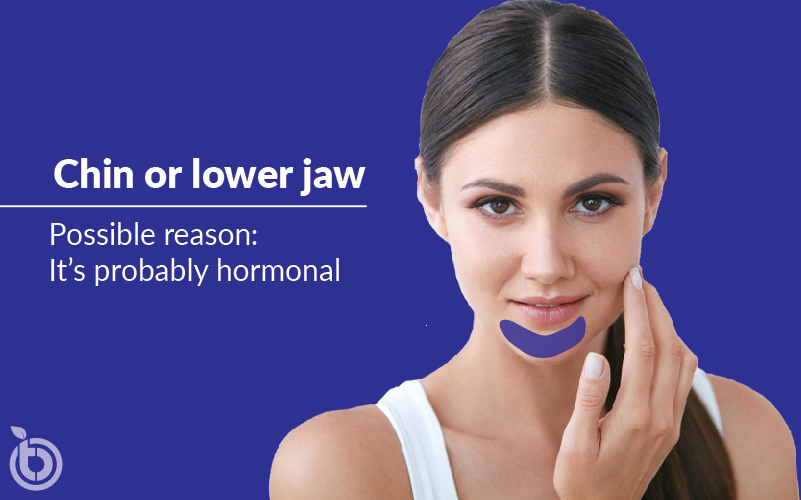
If your hormones are out of balance, especially if you have excess androgens (commonly referred to as “male hormones” like testosterone, though women also have and need them to a lesser degree), you may break out on the jawline or chin. That’s because these hormones can cause the oil glands to overproduce, leading to clogged pores where the bacteria that leads to acne can flourish.
If it is related to hormones, for women, the pimples often show up around a week before menstruation. It can also occur when birth control medications are started or switched.
Gut health can also affect hormone levels, which can then lead to increased acne. This may explain why some people feel like they break out more after eating dairy or sugars.
Hairline

While acne around the edges of the face (such as on the upper cheeks) could also be from hormone changes, it can also appear due to the pores being clogged by chemicals. For instance, some hair products contain oils or waxes to help keep the hair smooth (think pomade). Top that with moisturizers or makeups that irritate pores, and you may be setting up the perfect situation for a breakout.
If you start to notice pimples in these areas, you can try changing your beauty routine or products for some that are lighter and more natural. If you just can’t give up the offending hair product, try washing your face after you do your hair (and shield your face with a washcloth when applying) and regularly cleanse your hair and hairline.
Remember also to avoid repeatedly using the same headbands or hats without washing as the fabrics can deposit acne-causing bacteria to the edges of the face, which can encourage breakouts.
Cheeks
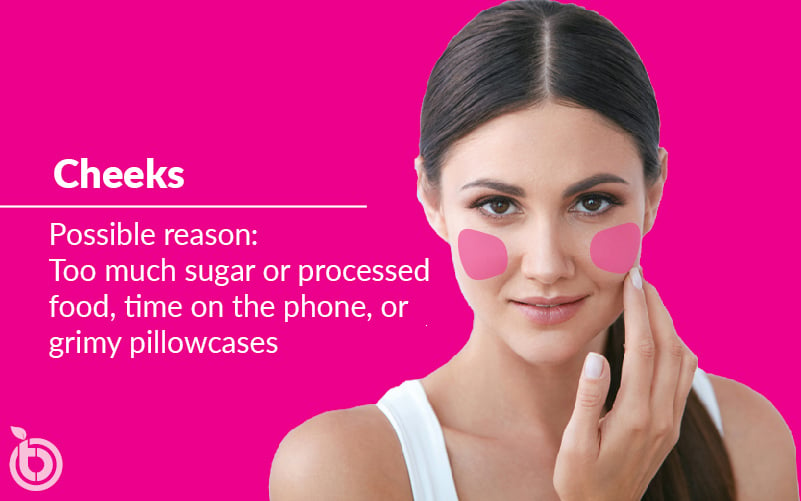
Noticing blemishes popping up on your cheeks? Look at your consumption of sugar or processed foods. It may not be a direct correlation, though. Instead, the increased blemishes may be related to gut health, which can affect hormone levels. Reducing your sugar or processed food consumption may help the cheeks clear up on their own as your gut gets healthier.
If you spend a lot of time chatting on the phone, make sure you also keep your phone clean. Cell phones, office phones, and home phones can all carry an abundance of germs along with oil and makeup and can invite bacterial growth.
BREAKING: Forget Taking Collagen, Try This 21-Second Trick for Healthier Skin & Hair Instead
Avoid taking your phone into unclean environments (e.g., bathrooms). And then regularly clean it (at least daily to several times per day) with disinfectant. Before picking up the phone, keep your hands clean, too, as many germs spread from countertops, keyboards, and doorknobs to the phones we tend to pick up over and over again throughout the day.
To clean, turn off the phone, wash your hands thoroughly with soap and water, and then use a soft microfiber cloth sprayed with an alcohol-based disinfectant and wipe off the phone front and back. (Follow the manufacturer’s directions to keep your phone safe and avoid getting moisture into ports, and never submerge it or spray cleaning fluid directly onto the phone.)
Alternatively, you can also use a UV sanitation device in addition to wiping off any visible grime.
Pillowcases can get pretty dirty, too, as can our hands. If you habitually touch your face throughout the day, that could be leading to your acne or making it worse, whether on the cheeks, chin, or forehead. And wash your pillowcases at least weekly or swap out with a clean one every few days to be more diligent.
Finally, if you tend to have small red bumps on your cheeks, it may not be acne at all, especially if it never comes to a head. Rosacea tends to show up on the cheeks and can be confused for acne.
While ayurvedic medicine indicated that acne on the cheeks could be associated with lung issues, current evidence does not support this theory.
Forehead
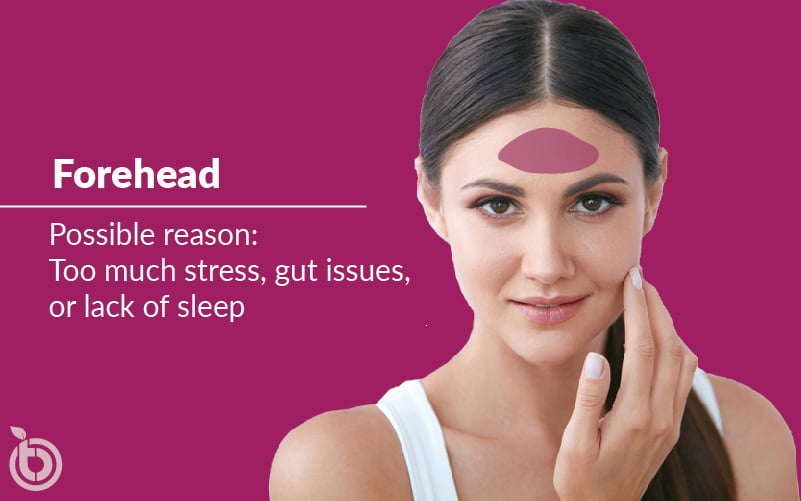
Ah, that pimple that shows up right before a big date or interview. It’s probably due to stress. And maybe your brain wouldn’t shut down, so you also lost some sleep. Or perhaps you had so much going on that you ate more for convenience than fuel, and your gut is now sending messages that it’s out of balance. It could be due to any of those, separately or combined.
If those pimples are showing up more often, take a look at your diet to ensure you’re supporting your gut microbiome, take a look at your sleep habits to make sure you’re getting enough, and take some time to relieve your stress. If that doesn’t help, it may be time to visit a dermatologist to see if they can help.
T-Zone
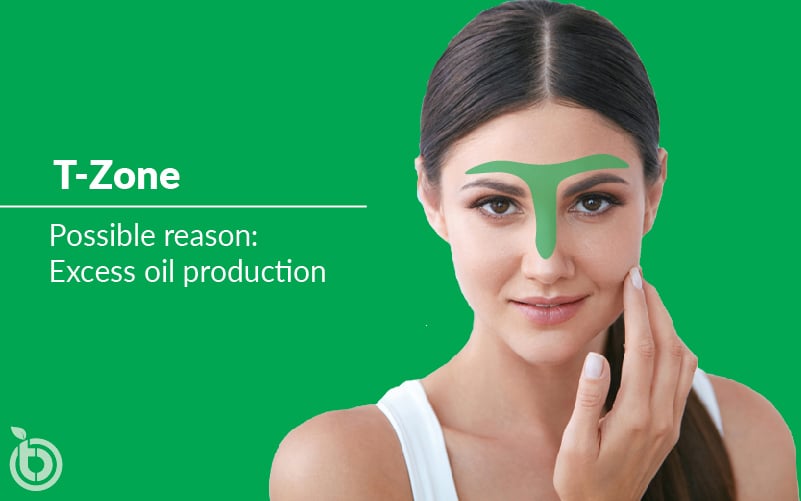
Many people have dry skin on the face but shine around the forehead, nose, and down to the chin (aka, the T-zone). In its wake, the skin is more likely to break out with either (or both) whiteheads and blackheads.
Acne in this area could also be tied to stress or lack of sleep. Ayurvedic face mapping traditionally associated this area with digestive issues and stressful experiences, including a lack of sleep or intense emotions.
SPECIAL OFFER: Ageless Turmeric Supports Healthy Inflammation Levels & Detoxification. Now Up to 71% Off.
It may also be because that’s where you tend to touch your face throughout the day.
Finally, beauty products and makeup can make these breakouts worse by clogging the pores. Switching to makeup that is “non-comedogenic” (non-pore-clogging) may help. And reducing the number of skin products used may also help.
Around the Mouth
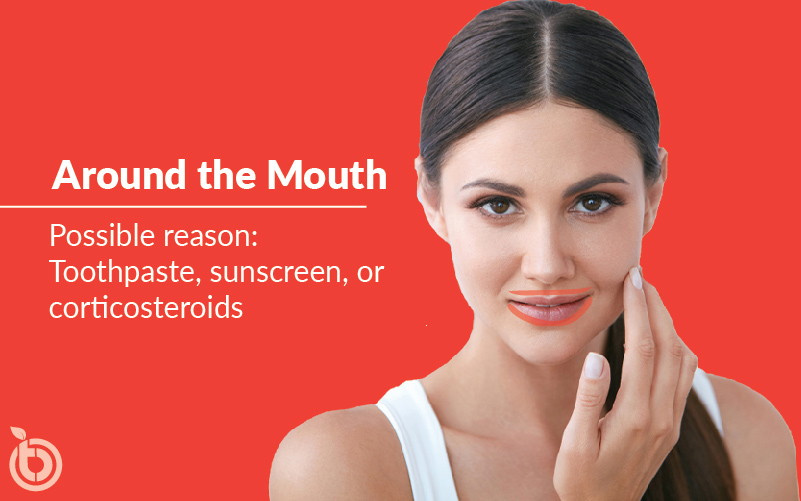
Of course, you need to brush your teeth. Oral hygiene is vitally important. However, some fluorinated toothpaste has been associated with acne-like rashes around the mouth (technically referred to as “perioal dermatitis”). This condition may also be a side effect of using topical or inhaled corticosteroids, sunscreens, or cosmetic creams.
To help the skin clear up, avoid using the offending facial creams and cosmetics and wash the face with warm water. If you are using a doctor-prescribed medication, please work with your doctor to ensure you’re safely removing any medications. And for sunscreen, choose a light, gentle liquid or gel.
It can take a couple of weeks to a couple of months to heal, and you may need to work with a dermatologist.
Top of Nose & Ears
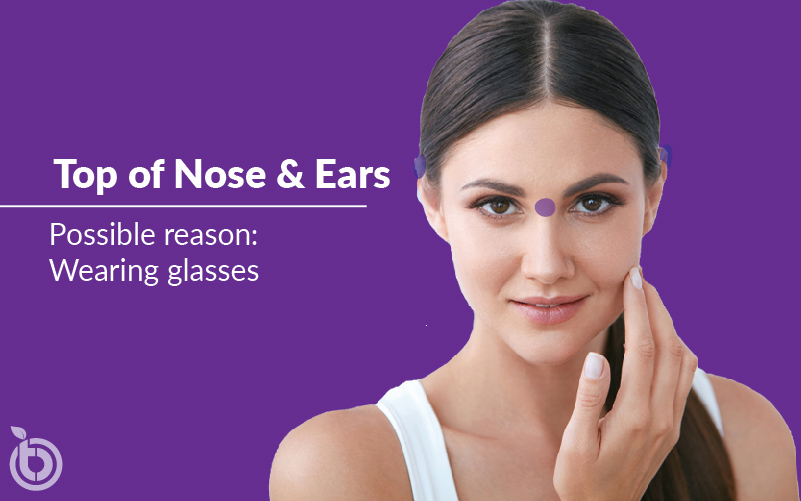
If you wear glasses and you’ve experienced blemishes under the nose or earpieces, you likely already put these clues together. Acne Mechanica is a type of acne caused by the increased friction, pressure, and heat from wearing glasses (sun, prescription, or reading) that press into oil glands.
Acne Face Mapping Learnings
Using acne face mapping can help provide clues on how to change or improve your skin, but it isn’t guaranteed to help. There are all sorts of reasons for pimples, blackheads, whiteheads, and other blemishes. But at least acne face mapping can provide a starting place and help indicate when you need to reexamine your beauty routine, hair products, or lifestyle.
Take a look at your environment as well. For example, dirt, sweat, oil, and dead skin cells can build up on your pillowcase, hat, scarf, or anything that touches your face throughout the day. Understandably, that grime can invite acne-causing bacteria and thus blemishes.
That goes for makeup brushes, sponges, cloths, and other beauty tools. They need to be appropriately cleaned regularly to remove any build-up.
Going to sleep without washing away the makeup, pollution, and dirt from the day may also clog pores and prevent the skin from renewing as you sleep. Foundation can be especially clogging, so make sure you remove it completely.
And if you find that nothing is helping, it may be time to seek professional help, especially if your acne is combined with other symptoms like fatigue, stomach problems, or other more severe problems. Your health-care practitioner can help you design the right regimen for your skin and hair type as well as look at other things that can encourage breakouts, including diet, travel, changing seasons or climates, medications, stress, and even genetics.
Before you pick at that pimple, know that you’re running a risk of making the problem worse. Popping pimples and black or whiteheads can cause you to push bacteria, pus, or dead skin cells deeper into pores, leading to increased inflammation and possibly scarring.
Finally, acne varies tremendously per person. Even if you’re breaking out in the same place as your best friend or sibling, the reasons could be different. People’s skin reacts differently to allergies, diet, environment, pollution, genetics, and more.
Different Types of Acne & Causes
The type of acne you experience can also help indicate why you are breaking out and what to do to help clear the skin:
Blackheads
Clogged with excess oil, dead skin, and dirt, hair follicles can appear black, and they can show up anywhere on the body, from the face to the back, chest, arms, and even ears. Most commonly, however, they’re visible on the nose. They’re caused by too much oil and are often seen as hormones rapidly change. That is, when you’re going through puberty, menstruating, pregnant, or going through menopause.
To help clear them, ensure the skin is being properly cleansed and that you’re regularly (but gently) exfoliating the skin to remove dead cells. Dermatologists may recommend salicylic acid, retinoids, or extractions.
Whiteheads
Technically referred to as “closed comedones,” they’re also clogged pores from excess oil and/or dead cells. To help clear the pores, use a gentle exfoliating cleanser.
Pimples
Also known as papules and pustules, these are the red-colored, inflamed, painful blemishes that most people think of when discussing acne. These are caused by bacteria overgrowth in clogged pores. Once the pus-filled head becomes apparent, it’s referred to as a “pustule.”
If pustules persist, they can form nodules that are deeper in the skin and can become very painful. If dealing with these, it’s time to make an appointment with a dermatologist.
Cystic Acne
This is the most painful and severe type of acne, evidenced by large, inflamed lesions deep under the skin. Unlike pimples and other forms of acne, these won’t form pustules and come to a head. Never try to squeeze or pop these as that can lead to deeper issues and scarring. Again, they should be treated with the help of a dermatologist.
How to Prevent and Heal Acne
If your acne is severe, you’ll want to enlist the help of a dermatologist. In the meantime, you may also help your skin heal by:
- Consuming an anti-inflammatory diet with plenty of colorful vegetables and fruits.
- Decreasing refined sugar, dairy, and processed foods in the diet.
- Supporting gut health.
- Decreasing stress levels.
- Exercising regularly.
- Cleansing the face with lukewarm water and a gentle cleanser twice a day as well as after sweating.
- Resisting the urge to touch the face throughout the day.
- Sleeping on clean sheets and pillowcases.
- Keeping hair away from the face and washing the face after putting on oily or waxy hair care products.
- Using quality topical treatments as needed.





 7 Signs Your Body is Seriously Low on Collagen (not just wrinkles)
7 Signs Your Body is Seriously Low on Collagen (not just wrinkles) Health Expert: "Turmeric Doesn't Work (unless...)"
Health Expert: "Turmeric Doesn't Work (unless...)" 3 Warning Signs Your Probiotic Supplement is a Total Waste
3 Warning Signs Your Probiotic Supplement is a Total Waste